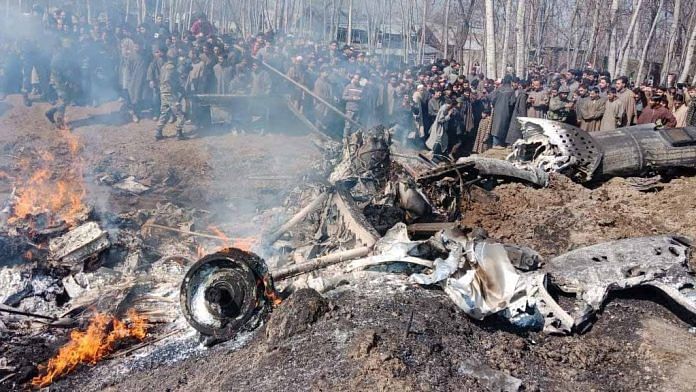New Delhi: The crash of a Mi-17 V5 helicopter in Budgam on 27 February, which killed seven people, including six uniformed personnel, was caused by friendly fire, a probe conducted by the Indian Air Force has ruled, according to highly-placed sources.
“The Court of Inquiry has found that the crash was a result of system failure. Two officers, the chief operations officer (COO) and the senior air traffic control officer (SATCO), have been found to blame,” a source told ThePrint.
The probe into the incident, which took place while the Indian and Pakistani air forces were engaged in a dogfight in the Nowshera sector around 100 km from Budgam, has also established that the helicopter was indeed shot down by the IAF’s own Israeli-made Spyder air defence system following the failure of command and control.
ThePrint had reported on 31 March that the chopper crash could have been caused by friendly fire.
‘Severe’ punishment
The report, which was submitted after nearly six months of detailed investigations, was submitted to the Air Headquarters earlier this month. Air Chief Marshal B.S. Dhanoa will now take a call on quantum of punishment that will be handed out. The officers could face court martial proceedings.
“Rest assured that the punishment will be very severe,” another source said.
Sources had told ThePrint on 21 June that the two officers could face court martial and another two could face limited action.
‘Lack of coordination’
Sources said at the time the chopper was hit by a missile it had been in contact with air traffic control (ATC) as it was approaching the air base.
“The ATC was in touch with the helicopter and knew it was coming back. However, the weapon operators fired because they felt it was an unmanned aircraft coming their way. There was complete lack of coordination,” a source said.
It is learnt that the IAF’s Barnala-based Integrated Air Command & Control System, which is tasked with monitoring incoming aircraft from Pakistan, had not designated the helicopter a ‘Red’, the classification for enemy aircraft.
The helicopter’s ‘Identification of Friend or Foe’ system — a transponder-based identification system — was switched off. Sources said despite directions from the Air Headquarters to have the transponder on all the time, the practice at the Srinagar Air Base was to switch it off because it interferes with civilian aircraft transmissions, and also because the aircraft could be identified by the enemy during battle.
“It was indeed a system failure that led to the crash. Proper protocols were not adhered to. The COO was the person in charge of the operations at the time,” a source said.
Also read: 10 crashes, 11 aircraft lost, 22 killed — the year of Balakot has been a bloody one for IAF




Fida Sayani Overall pretty expensive losses by Indian Airforce in a fight in which they lost aircraft’s to the Pakistani pilots and loosing chopper to the friendly fire. Hope they have learned the lesson. I must remind them about M. M. Alam a Bengali Airforce pilot of the Pakistan Airforce, who shot down as much as 9 Indian planes in the 1965 war. Bottom line don’t mess around with Pakistani Airforce.
Please talk about corrunt plane crash
The detailed investigation could have taken time, although not six months. That was required to understand issues with sufficient clarity to rework SOPs for the future, also to fix responsibility and to decide on what action required to be taken against those who were at fault. However, by the time the sun set on 27th February, the IAF and the entire civilian establishment would have been aware of the nature of this tragedy. Kept back from all, including the grieving members of the families of those who perished.
With barely a week left for him in office, I wish the ACM takes a stern action as promised. Also, just for you and your readers to know, the Mirage 2000 crash in Bangalore happened 26 days before this tragic incident/mass killing. Yet to get any clarity on its closure, even though everyone in the inner circle knows about the misadventure of HAL. No officer will come out and speak as a fauji is denied of basic fundamental rights, the right to freedom of speech. Even if they do, their promotions are at stake as it is a fine machinery which works on a babu format and no one wants to see their boss red-faced.
I hope as a veteran from few days from now, the Air Chief Marshal will help us know what exactly went wrong and why no action has been taken. ( Though i still hope a week is enough for him to come out and let the world know ).
I wish the pilots of the HAL had come out of their Stockholm syndrome and spoken the truth as civilians, but raking in moolah they didn’t give a damn except making foolish statements like betting their life on the jet.
We had high expectations, but they all happen to crumble under the political pressures as a state owned agency killed two brilliant test pilots and ended their ambitions of boarding the GAGANYAN, the day for which they had been toiling for years.
Let truth prevail !
Hahaha…we have such intelligent people in the armed force…..